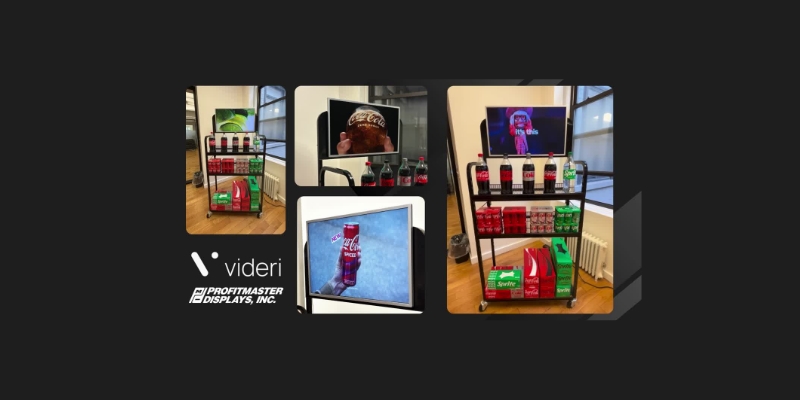Weighing Differences and Benefits for 2 Very Distinct Technologies
eInk and ePosters are increasingly appealing to businesses seeking cost-effective, sustainable alternatives to traditional print, offering the thinness of posters with minimal energy consumption. Also, like posters, they need to be easy to use and install.
Otherwise known as color electrophoretic displays, eInk has improved since the technology was originally conceived in the 1970s. In 1997 the first eInk powered product was launched in black and white, and over time layers of color were added to create the color variations on the eInk displays in-market today. Many businesses have waited with anticipation for the technology to evolve, so there is established demand for a paper poster alternative.
During the same time frame digital display technology re-leveled expectations for screen clarity and color, and the muted hues of ePaper were not landing well with customers. The technology continues to evolve, and with the flexibility of eInk customers can solve problems that LED and LCD displays cannot. Especially in small formats like Electronic Shelf Labels (ESL)s and eReaders.
That said, let’s compare apples to apples, at least in terms of size (32” & above) and see where large ePaper displays land compared to the Videri Spark Digital Canvas. If you’ve been reading our blogs, you already know how Videri is different from traditional digital displays, but how does Videri stack up to ePaper?

Shared Benefits
ePaper and Vider Canvases have a lot of similar benefits. Let’s start there:
- Small unique sizes, that fit where most traditional displays don’t
- Universal mounting system (VESA)
- Thin and unintrusive, ADA compliant
- Low power consumption
- Turnkey – all materials for installation in-box
- System on Chip (some ePaper products are SoC – not all)
- Wireless via Wi-Fi and/or Bluetooth
Videri Advantages
This might come as a shock, but at 15.5mm (including the mount) Videri Spark Digital Canvases are thinner than the thinnest ePaper products in the market. How else does Videri stand out?
- Standardized bezel width across all Canvases for seamless Walls and multi-display designs
- LCD screens with precise color calibration between any sized Canvas
- 16 million colors possible
- High haze coating to virtually eliminate glare in sunlight
- Content changes are instantaneous with no flickering or time-lag
- 178° viewing angles in both portrait and landscape
- Integration with Videri enterprise-grade CMS & device management software (or with one of our CMS ecosystem partners)
- Android based for easy integrations (some Android based ePaper is in market and is reported to have poor battery life)
- Plays videos, images, HTML, apps and more
- Ability to orchestrate synchronized content across multiple Canvases to create engaging and beautiful video walls
ePaper Advantages
- ePaper works better with more light, making them well suited for sunny front windows and outdoor displays
- With fewer components ePaper is very light weight which lends itself to innovative mounting solutions
- Can embed batteries and run off battery for days
- Static images require a small amount of power, the majority of which is used when changing the image
The 7 Challenges with ePaper
- Expensive: 32” and above sized ePaper products are 30-40% more expensive than our most expensive Canvas (our unique square SparkQ).
- No video capabilities: Recently “a partial image flashing” effect was designed to deliver the appearance of motion in ePaper.3 Multiple studies show that video converts better than static images and most businesses want to capitalize on that.
- Not tamper proof on-site: They have a USB input that poses on-site security risks.
- Poor color representation: ePaper has improved and is suitable for many use-cases as described above, but in large format it may not live up to customer expectations for color. The industry standard ePaper displays about 60,000 colors.
- Basic content management: Content on USB sticks, bluetooth delivery via Mobile Phone Apps, or limited Wi-Fi connection to basic CMS.
- Resources: All changes to content are manually driven at the time of need and require more focused resources to keep content fresh and targeted.
- Low refresh rate: Considered one of main drawbacks of eInk, color transitions take time on ePaper 4. For color displays it can take 5 to 10 seconds for ePaper content to fully change over, during which time there is significant screen flashing and flickering. This is usually mitigated by changing content infrequently and/or during off hours.
It’s a simple equation. Videri customers are getting more value from their Spark Canvas and CMS than large format ePaper can provide – based on the high price point and limitations of the eInk technology today. That said, we are constantly exploring emerging technology like ePaper to see how it can benefit our customers, and we will continue to make sure our solution and our ecosystem adapt to those use-cases.
Want to get more value out of your digital displays? Contact Videri today.






